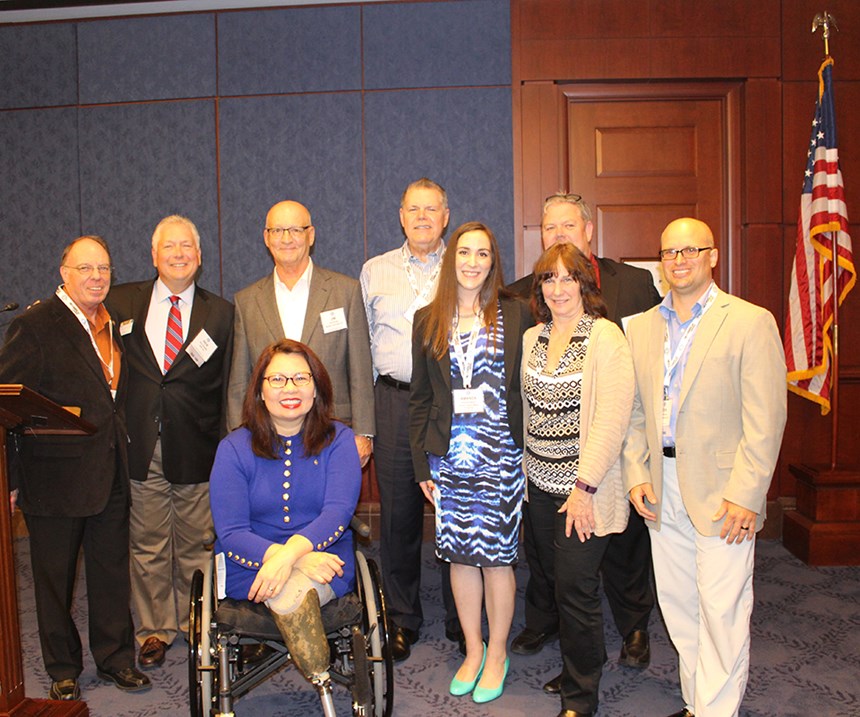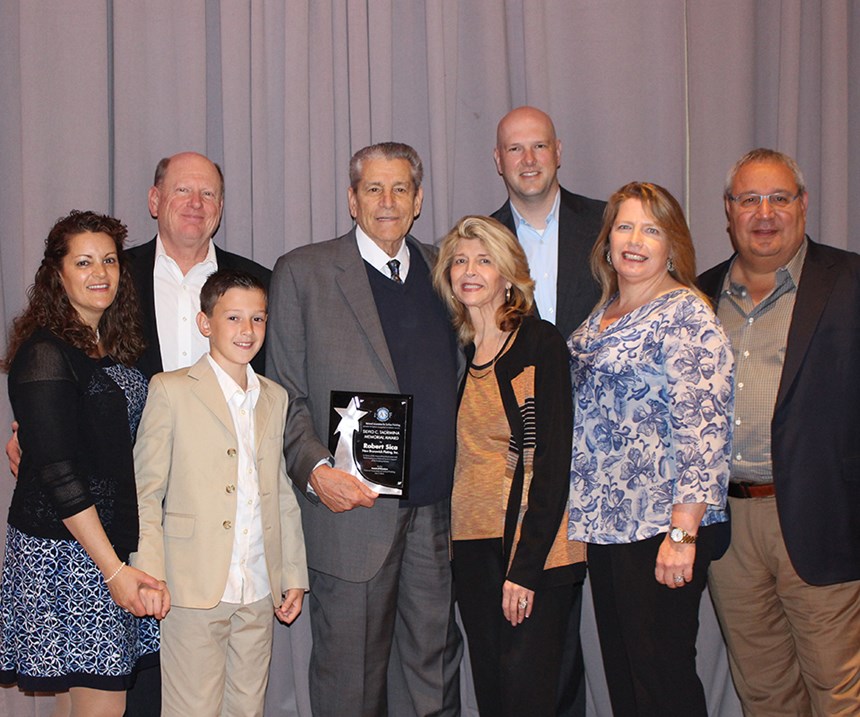NASF Report: June 2017
NASF invites top policy analysts and keynotes to the Washington Forum, and the industry gears up for the Sur/Fin Manufacturing and Technology Trade Show and Conference.
#nasf #surfin
The 2017 Washington Forum: A New Atmosphere
Attendees at this year’s Forum met in an atmosphere distinctly different from recent industry meetings in Washington. Coinciding with President Trump’s first 100 days in office, the event hosted national figures from both parties and gave industry leaders the chance to discuss pertinent issues in surface finishing.
Successes and Predictions: Deregulation, NAFTA, Taxes and Others
Featured Content
Attendees heard contrasting perspectives on the President’s agenda from former Trump campaign manager Corey Lewandowski. Lewandowski, who continues to be a close outside advisor to the President, offered insight into Trump’s freewheeling campaign and governing style, his early success for business on deregulation, and the far-reaching impact of Supreme Court appointments.
Politico magazine founder and media entrepreneur Jim VandeHei also addressed attendees. VandeHei, who recently launched the new political media company Axios, highlighted the President’s risks and vulnerabilities as well as issues surrounding the “super polarization” in U.S. politics and media, a trend he argued will make the nation worse before it gets better.
On automotive issues, Ann Wilson, senior vice president of the Motor Equipment Manufacturers Association (MEMA), noted that NAFTA is more than 20 years old and an update is appropriate. She highlighted concerns suppliers have about the unintended consequences for the automotive industry if the White House and lawmakers on Capitol Hill aren’t careful in tackling the issues.
Economist Peter Morici and Washington trade counselor Skip Hartquist both noted that the U.S. could benefit from minimal changes to NAFTA and that the U.S.-China trade relationship needed much more attention going forward. Returning keynote Andy Friedman of “The Washington Update” rounded out the discussion with a review of tax and budget policy. He pointed to the economic benefits of deregulation and how potential tax reform changes could benefit small and medium sized U.S. manufacturers.
NASF Reception with Guest U.S. Senator Tammy Duckworth
U.S. Senator Tammy Duckworth (D-Illinois) told the Forum’s Capitol Hill reception attendees of her aim to tackle workforce quality and training needs for manufacturers. Her comments echoed the remarks on rebuilding small manufacturing from speaker Tom Sullivan, vice president of Small Business Policy at the U.S. Chamber of Commerce.
In introducing Duckworth, NASF Government Advisory Committee Chairman Rick Delawder noted that the association is always ready to work with both sides of the aisle to get the right things done for the industry. He highlighted the recent NASF Job Shop survey showing workforce availability as the top issue for member companies in the first quarter of 2017.
Environmental, Health & Safety Developments: U.S. and Europe
Some of the best news at the Forum included the release of a recent NASF case study on the industry’s wastewater treatment trends. The findings show a major environmental success story for finishing. John Lindstedt of Advanced Plating Technologies in Wisconsin, who oversaw the study with the NASF Government Advisory Committee and NASF headquarters, summarized the changes made by the industry on wastewater control trends.
The study gives the EPA more data to help decide this summer on whether to propose a new round of potentially more stringent federal surface finishing effluent regulations under the Clean Water Act. NASF presented the study to EPA water officials later in the week following the Forum.
Even with a deregulatory agenda informing the agency, EPA is still expected to implement major chemicals regulations in the coming year since proposed by Congress last year under the Toxic Substances Control Act (TSCA). Republicans and Democrats on Capitol Hill want to ensure the agency is carrying out the law, which includes identifying a list of high priority chemicals that will be selected from a longer existing list that includes several metals, including nickel. David Fischer, a senior director at American Chemistry Council, briefed attendees on which TSCA provisions to watch in the coming months.
On the health and safety front, David Sarvadi of Keller & Keckman gave an overview of the key policy reversals so far at the Department of Labor, including OSHA’s injury and illness reporting rules, the overtime rule, and other pending changes. Sarvadi noted that the new leadership likely to take the helm soon at OSHA will take a markedly different approach to the workplace than those in the previous administration.
Dr. Hudson Bates, head of the Nickel Producers Environmental Research Association (NiPERA), gave a global update and pointed to California, Oregon and other states as sources of more stringent air regulations for finishing in the coming months. NASF’s Christian Richter and Jeff Hannapel confirmed the industry would see more regulatory action from certain states and noted that NASF headquarters will be joining Southern California finishers for meetings in the coming weeks on a precedent-setting air emissions rule in Los Angeles.
Because Europe and the states also remain in the regulatory mix, NASF hosted both new and familiar speakers to the Forum. Rainer Venz, President of the German Electroplaters Association, gave a European policy update to the Forum. He pointed to European Union regulatory actions under the REACh chemicals framework, some of which could affect North American finishing.
The Plating Shop Closest to the White House
Attendees got a break from policy matters to hear from Steve Olszowy, plate making supervisor at the Bureau of Engraving and Printing at the U.S. Department of the Treasury. Olszowy introduced the crowd to his work in producing and plating the plates that print U.S. currency.
He walked through each step of the process, including nickel and chrome plating, where a printing plate is coated with a thin layer of chrome that contains the currency image in recessed grooves only 0.002" deep. The plating shop and related production processes are just across the Mall from the Washington Monument.
NASF Industry Advocacy in Congress and at EPA
Several NASF state delegations went to Capitol Hill on the last day of the Forum to visit House and Senate representatives. They shared the industry’s priorities on regulation, trade and taxes with members and legislative staff. Representatives of the NASF Government Advisory Committee—John Lindstedt, Becky Bennett (Precision Plating Company) and Rick Delawder (SWD Inc.)—joined NASF’s lobbying team, Christian Richter and Jeff Hannapel, for meetings with EPA on the agency’s upcoming decision on whether to revise the finishing industry’s existing effluent guidelines.
Bob Sica Receives NASF Taormina Award
One of the top highlights of the Forum was the presentation of the Taormina Award to Bob Sica of New Brunswick Plating in New Jersey. NASF president, Paul Brancato, who introduced Bob, noted the effectiveness and consistency of Bob’s leadership and contributions over time to the industry, the association, his business and his family. Bob expressed with heartfelt gratitude how thankful he was to be a part of the industry for many years and for his opportunity to give back for the greater good of the association. Bob was joined by his wife, Doff, and other family members and friends for a truly memorable moment.
Additional information and Washington Forum materials are available by contacting Jeff Hannapel (jhannapel@thepolicygroup.com) or Christian Richter (crichter@thepolicygroup.com).
In Memoriam: David Marsh
The industry lost an iconic figure in the passing of David Marsh, previous owner of Marsh Plating, who died unexpectedly at his home in Bridgewater, Michigan.
David’s contribution to the advancement of the surface finishing industry was far reaching, both technologically and from an advocacy standpoint educating the regulatory community as to the importance of surface finishing in preserving the nation’s natural resources.
David’s many skills were quickly recognized by his peers in the surface finishing industry, resulting in him ascending to leadership positions in the industry’s various trade associations. He was one of the individuals most responsible for coordinating the government relations of the three trade associations at the time representing the management, technical and supplier segments of the industry into a single group known as the Government Advisory Committee.
It was this committee that was involved in ground-breaking collaborative programs with the EPA, most notably the Common Sense Initiative, which was created as part of President Clinton’s Reinventing Government initiative. David was also a well-respected and vocal supporter of the need for trade association consolidation, which led to the creation of the National Association for Surface Finishing.
Industry Night at Sur/Fin
NASF Sur/Fin invites you to Industry Night with a Halftime Event: Tuesday Night Tailgate at the College Football Hall of Fame. Pull out your favorite college sweatshirt to celebrate achievements and “tailgate” with other attendees, exhibitors and speakers.
Tuesday, June 20 | 6 p.m.
250 Marietta Street NW, Atlanta, Georgia 30313
$75 Per Person, food and drinks included
Reserve your spot while registering for Sur/Fin or visit nasfsurfin.com/attend/industry-night for more information.
About the Hall of Fame
• Get private access to the entire Hall of Fame
• Enjoy a custom high-tech experience customized to your favorite team
• Dive into “game day” in the ultra-high definition theater
• Test your skills on a 45-yard field replica
• Call the shots as a game-day analyst
• Show your spirit in fight song karaoke
For more information regarding Industry Night at Sur/Fin, contact Cheryl Clark at 302-436-5616 or cclark@nasf.org.
Originally published in the June 2017 issue.
RELATED CONTENT
-
Masking for Surface Finishing
Masking is employed in most any metal finishing operation where only a specifically defined area of the surface of a part must be exposed to a process. Conversely, masking may be employed on a surface where treatment is either not required or must be avoided. This article covers the many aspects of masking for metal finishing, including applications, methods and the various types of masking employed.
-
An Overview of Electroless Nickel Plating
By definition, electroless plating is metal deposition by a controlled chemical reaction.
-
Zinc Electroplating
Choosing the best process for your operation.























